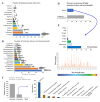Marine eukaryote bioluminescence: a review of species and their functional biology
- PMID: 40417256
- PMCID: PMC12102453
- DOI: 10.1007/s42995-024-00250-0
Marine eukaryote bioluminescence: a review of species and their functional biology
Abstract
Bioluminescence, the ability of organisms to produce visible light, has intrigued scientists for centuries. Studies have examined bioluminescence, using a wide range of approaches and organisms, from its ecological role to its underlying molecular mechanisms, leading to various applications and even a Nobel prize. Over the last ten years, an increasing amount of data has been collected leading to a growing number of recognized marine bioluminescent species. This review provides and describes a referenced listing of the eukaryotic luminous marine species, including information related to: (i) intrinsic versus extrinsic source of the bioluminescence, (ii) the color and maximum wavelength of emission, (iii) the bioluminescent system (substrate and enzyme) and the associated molecules, (iv) the availability of light organ/cell(s) pattern and histological structure, (v) the physiological control of the light production, and (vi) the demonstrated or suggested bioluminescent function(s). This listing provides basic information and references for researchers in or entering in the field of marine bioluminescence. Using a semi-quantitative approach, we then highlight major research gaps and opportunities and reflect on the future of the field.
Supplementary information: The online version contains supplementary material available at 10.1007/s42995-024-00250-0.
Keywords: Bioluminescence functions; Bioluminescence system; Diversity; Luminescence; Taxonomy; Wavelength.
© The Author(s) 2024.
Conflict of interest statement
Conflict of interestThe authors declare no competing interests.
Figures



Similar articles
-
Terrestrial and marine bioluminescent organisms from the Indian subcontinent: a review.Environ Monit Assess. 2020 Nov 5;192(12):747. doi: 10.1007/s10661-020-08685-5. Environ Monit Assess. 2020. PMID: 33150454 Review.
-
Glowing Worms: Biological, Chemical, and Functional Diversity of Bioluminescent Annelids.Integr Comp Biol. 2017 Jul 1;57(1):18-32. doi: 10.1093/icb/icx017. Integr Comp Biol. 2017. PMID: 28582579 Review.
-
Etmopterus spinax, the velvet belly lanternshark, does not use bacterial luminescence.Acta Histochem. 2019 May;121(4):516-521. doi: 10.1016/j.acthis.2019.04.010. Epub 2019 Apr 23. Acta Histochem. 2019. PMID: 31027729
-
A Tale Of Two Luciferins: Fungal and Earthworm New Bioluminescent Systems.Acc Chem Res. 2016 Nov 15;49(11):2372-2380. doi: 10.1021/acs.accounts.6b00322. Epub 2016 Sep 26. Acc Chem Res. 2016. PMID: 27696815
-
Light emission miracle in the sea and preeminent applications of bioluminescence in recent new biotechnology.J Photochem Photobiol B. 2017 Jul;172:115-128. doi: 10.1016/j.jphotobiol.2017.05.021. Epub 2017 May 17. J Photochem Photobiol B. 2017. PMID: 28549320 Review.
References
-
- Anctil M (1979) Physiological control of bioluminescence. Photochem Photobiol 30:777–780
-
- Anctil M (1987) Neural control mechanisms in bioluminescence. In: Ali MA (ed) Nervous systems in invertebrates. Springer, Boston, MA, USA, pp 573–602
-
- Anctil M (2018) Luminous creatures: the history and science of light production in living organisms. McGill-Queen’s University Press, Montreal
-
- Anctil M, Case JF (1976) Pharmacomorphological study of denervation induced by 6-hydroxydopamine in Porichthys photophores. Cell Tiss Res 166:365–388 - PubMed
-
- Anctil M, Boulay D, Larivière L (1982) Monoaminergic mechanisms associated with control of luminescence and contractile activities in the coelenterate, Renilla köllikeri. J Exp Zool 223:11–24
Publication types
LinkOut - more resources
Full Text Sources

